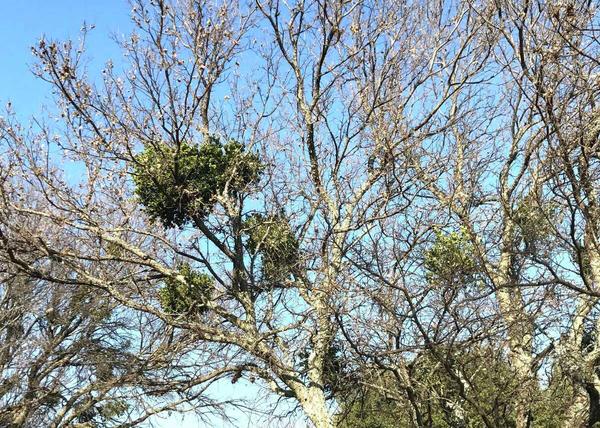Ball moss, lichen and mistletoe: Which ones will damage your trees in Texas and which are safe
The disease is easy to prevent but difficult to cure and will result in the death of individual red oaks and live oaks at the rate of 100 feet or more per year.
Whenever I talk about oak wilt, questions come up about mistletoe, ball moss and lichen. Here’s what you need to know.
Mistletoe
Mistletoe is a parasite that draws its nutrients and moisture from the plant on which it is growing. The question becomes is the stress that mistletoe causes to its host enough to justify a control program?
Mesquite is the most common tree in our area for mistletoe to prey upon. The horizontal pattern of branching, limited foliage and deep furrowed bark seem to meet the mistletoe’s needs for germination, growth and reproduction.
Despite being toxic to humans, dogs and some other mammals, the mistletoe berry is a favorite food of birds. They do most of the mistletoe seed distribution.
Mistletoe plants can be removed with the use of a pole saw or pruner to be collected, bagged and sent to the landfill. The mistletoe penetrates the host tree’s vascular system with an organ called a haustoria. Mistletoe removed from a tree will resprout from the remnant of the haustoria a few years later.
It is hard to determine how much stress the mistletoe causes the host trees. I am not familiar with an instance when mistletoe parasitism has ever been credited with being the main cause of killing a tree. If you are interested in fascinating plant relationships and encouraging bird activity, it is easy to justify leaving the mistletoe plants in place, even if they are a tree parasite.

Ball moss
Ball moss is not a parasite; it is an epiphyte (air plant) unique to Central Texas. Epiphytes are plants that get their sustenance from the air where they find the moisture and nutrients they need to grow and produce seed.
The shaded, often leafless branches in the middle of a live oak tree are ideal sites for the seeds to land and germinate, but they also will grow on crepe myrtle, pecans and even utility lines.
The ball moss on dead or declining live oak branches is not a factor in the decline of the branches, but you can remove it if you do not like its looks. Sometimes there is so much ball moss, the shade produced can have a negative impact on the tree or the plant life below.
Physically remove it with a pole pruner or saw or spray it with copper hydroxide in February. Pest control firms and tree services companies will apply the spray or physically remove the ball moss for a fee.
Lichen
This week in the gardenIf your sweet peas and English peas fell victim to this month's freezes, there is still time to plant new seeds. Soak the seeds overnight before planting. Use a trellis or tomato cage to provide a plant suport.
If you have unwanted seedlings in your fence line and garden beds, the herbicide Cut Vine and Stump Killer works to kill the root system even if the plants have dropped their leaves.
Snapdragons, petunias, stocks and other cool-weather flowers will return to blooming after a midwinter pause. They will often bloom until late April if the temperature is mild.
Potatoes can be planted in trenches 1 foot deep in early February. Initially cover the pieces of potato that have eyes with 2 inches of soil. Refill the trench with soil as the potato plant emerges from the initial soil.
Lichen is another plant that is a mystery to many gardeners and is sometimes blamed for damage to trees for which it is not responsible.
Lichen is more accurately a plant community than a single plant. Various algae and fungus grow together to produce a layer on tree surfaces or even rock surfaces. The relationship between the algae and fungus can be complex and/or one-sided but in the simplest terms, like ball moss, the lichen pulls its moisture and nutrients from the air, processing that by one or both of the partner plants for their mutual benefit.
Not only is lichen growing on tree bark not hurting the tree, but it is an indicator that the air in the vicinity is relatively free of pollutants as lichen only prospers in areas where the air is clean. There is no advantage in removing lichen by physical or chemical means from a tree trunk.
Calvin Finch is a retired Texas A&M horticulturist. calvinrfinch@gmail.com







